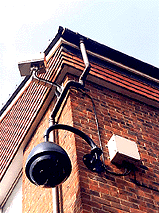

There are several serious problems with using traditional coaxial or even high-tech fiber-optic cables to transmit video images from the surveillance cameras to the stations at which the images are monitored and/or recorded. Cables are easily damaged or severed by bad weather, birds, insects, accidents or saboteurs, and thus require nearly constant monitoring, maintanence and repair. Furthermore, cables cannot be strung over long distances without sacrificing image quality or having to build expensive booster stations along the way. The use of cable thus necessitates the close physical proximity of the monitoring stations to the areas under video surveillance. But proximity might be undesirable if the surveillance is intended to be covert or impossible if the subject of surveillance is constantly on the move.
To solve these problems, video surveillance has gone wireless. There are several means by which live video images can be transmitted without the use of cables or wires: lasers, radar signals and radio (all of which are "microwaves," differing only in frequency on the spectrum). The most commonly used microwave is radio-frequency ("radio" for short). Radio broadcasts intended to travel long distances usually make use of ground-based antennae or satellites that relay the signal from the transmitter to the receiver. Broadcasts intended to travel short distances are usually beamed "point-to-point," that is, directly from the transmitter to the receiver. (Unfortunately for the people who visit and work in the area, an example of a high-powered point-to-point system can be found right in the heart the New York City's Times Square.)
In England, whole towns are covered by complex networks of point-to-point systems. In this schematic, which explains the operation of the secure system in which the wireless surveillance camera depicted above is an element, note that the video-signal is first "modulated" (encrypted), then relayed through a "control room," at which it is "demodulated," then relayed through a "node," at which the signal is modulated again, before it finally reaches the police station, where it is (no doubt) finally unencrypted and watched and/or recorded.
In America, many law enforcement agencies use radio signals to transmit, relay and receive live video images. These agencies include the California Highway Patrol, the US Border Patrol and the the New York Police Department (NYPD). Their use of wireless cameras can either be covert or overt.
In covert operations ("stake-outs"), the cameras are usually small devices that beam their signals over short distances (usually to an unmarked van or car parked nearby) from hidden, semi-permanent locations on or near the suspects. In overt operations ("routine patrols"), the cameras are usually large devices that beam their signals over relatively long distances (back to headquarters or some other command-and-control center) from their mounts atop news-style vans or mobile command centers (usually buses). Overt wireless spy cameras can also be installed on helicopters, planes, unmanned aerial vehicles and satellites.
Whether used covertly or overtly, wireless video is a risky business for two reasons: 1) though such transmissions are often "modulated" or otherwise encrypted, they are nevertheless sent on "open," non-secured frequencies, and so can be intercepted and, given time, decoded; and 2) officers routinely stationed near the transmitters can suffer serious health problems if over-exposed to microwave radiation.
(Originally posted on 31 March 2001. Substantially modified 1 September 2003.)
By e-mail SCP@notbored.org
By snail mail: SCP c/o NOT BORED! POB 1115, Stuyvesant Station, New York City 10009-9998